Environmental History: A Comparison of Colorado and Snowy Rivers
VerifiedAdded on 2023/01/11
|10
|3697
|20
Essay
AI Summary
This essay provides a comparative analysis of the environmental histories of the Colorado and Snowy Rivers, focusing on the impact of engineering projects such as dams and hydroelectric schemes. The introduction defines environmental history and its significance in understanding human-nature interactions. The main body delves into the specifics of each river, detailing the Snowy Mountains Scheme in Australia and the intensive water management of the Colorado River in the United States. The essay explores the environmental consequences of these projects, including altered river flows, temperature changes, and impacts on aquatic ecosystems. It also examines the socio-political contexts, including government involvement, public campaigns, and water agreements. The conclusion summarizes the key findings and emphasizes the importance of considering environmental impacts in engineering projects. The essay highlights the varying approaches to river management and the challenges in balancing human needs with ecological preservation, drawing attention to the long-term consequences of human interventions in natural systems and their implications for sustainable water management practices.
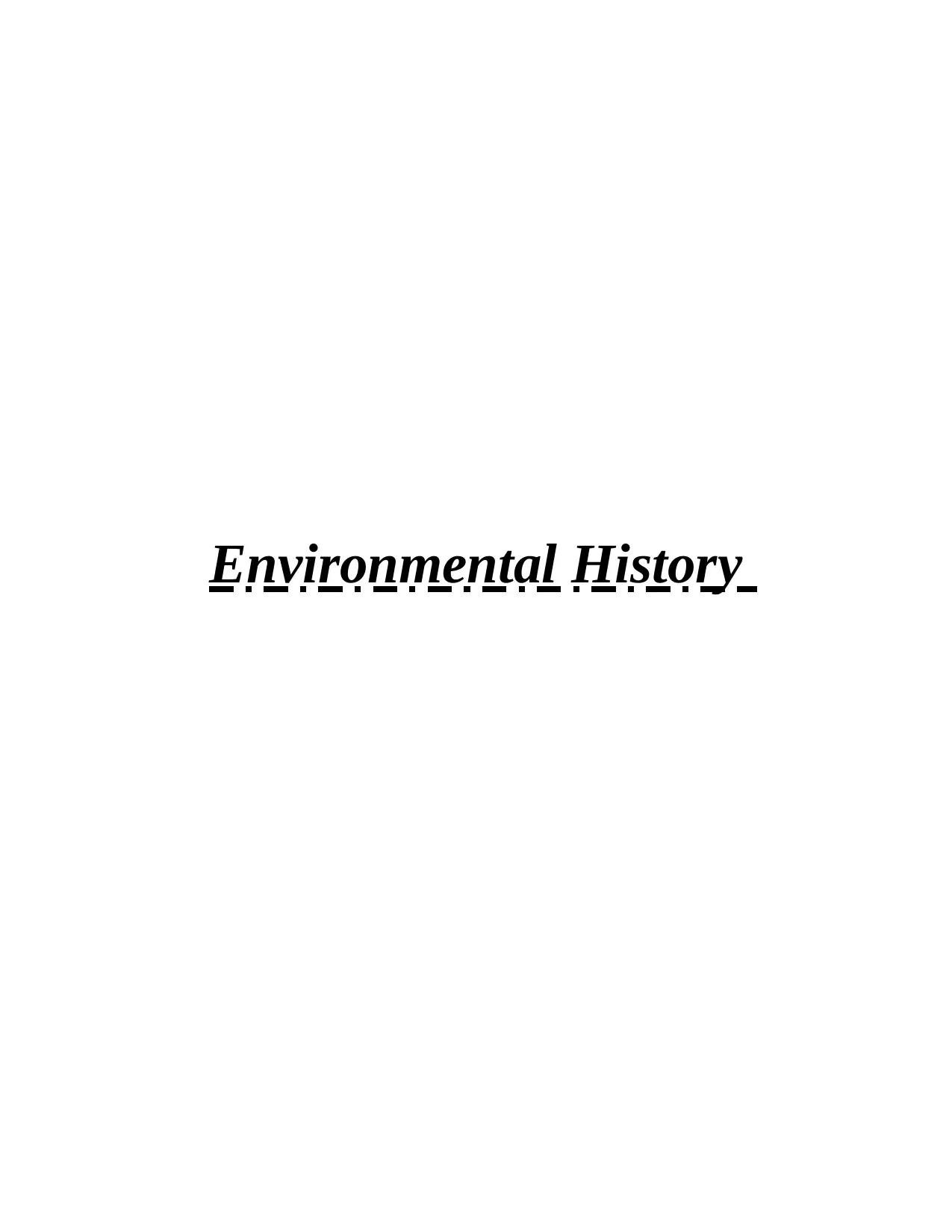
Environmental History
Paraphrase This Document
Need a fresh take? Get an instant paraphrase of this document with our AI Paraphraser

Table of Contents
Introduction......................................................................................................................................3
Main Body.......................................................................................................................................3
Conclusion.......................................................................................................................................9
References......................................................................................................................................10
Introduction......................................................................................................................................3
Main Body.......................................................................................................................................3
Conclusion.......................................................................................................................................9
References......................................................................................................................................10
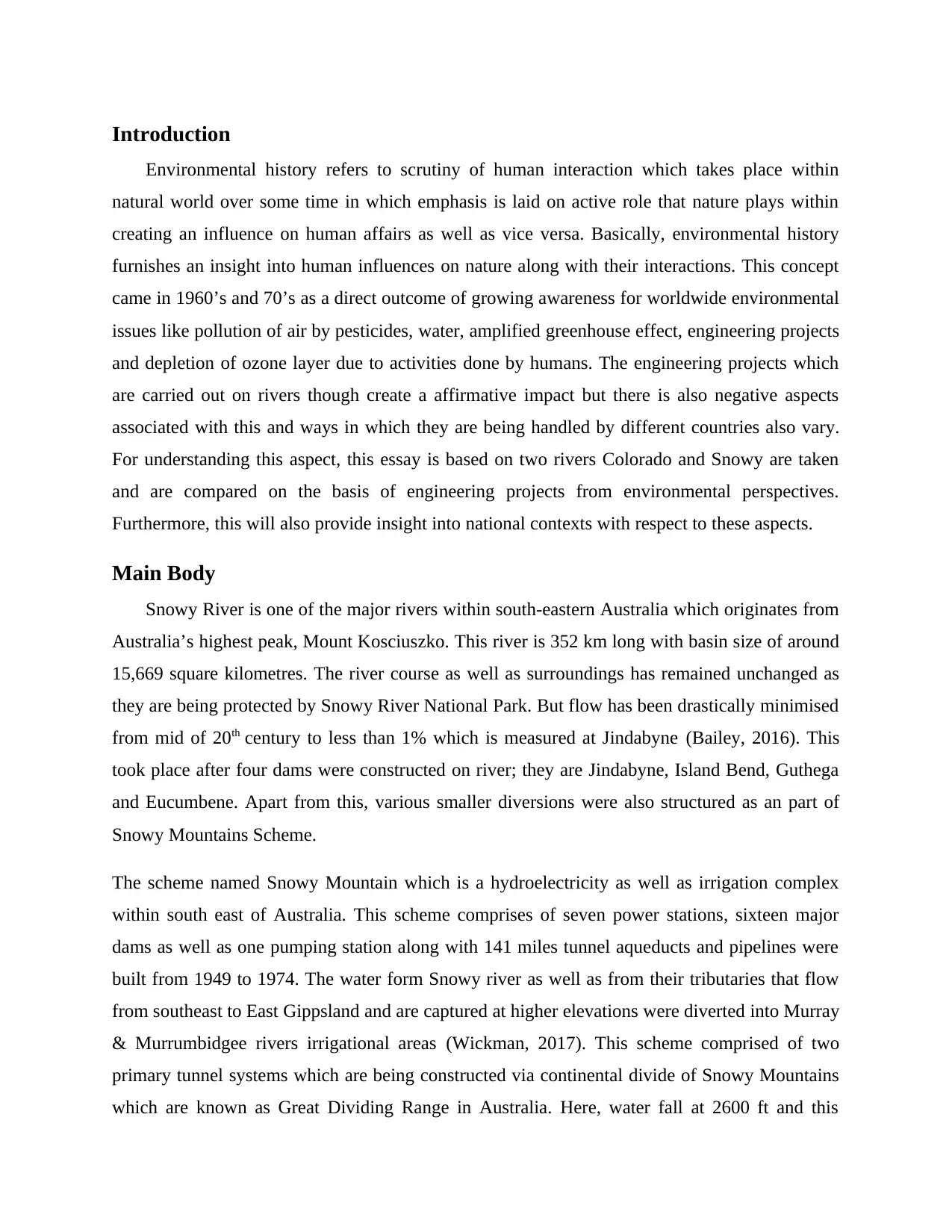
Introduction
Environmental history refers to scrutiny of human interaction which takes place within
natural world over some time in which emphasis is laid on active role that nature plays within
creating an influence on human affairs as well as vice versa. Basically, environmental history
furnishes an insight into human influences on nature along with their interactions. This concept
came in 1960’s and 70’s as a direct outcome of growing awareness for worldwide environmental
issues like pollution of air by pesticides, water, amplified greenhouse effect, engineering projects
and depletion of ozone layer due to activities done by humans. The engineering projects which
are carried out on rivers though create a affirmative impact but there is also negative aspects
associated with this and ways in which they are being handled by different countries also vary.
For understanding this aspect, this essay is based on two rivers Colorado and Snowy are taken
and are compared on the basis of engineering projects from environmental perspectives.
Furthermore, this will also provide insight into national contexts with respect to these aspects.
Main Body
Snowy River is one of the major rivers within south-eastern Australia which originates from
Australia’s highest peak, Mount Kosciuszko. This river is 352 km long with basin size of around
15,669 square kilometres. The river course as well as surroundings has remained unchanged as
they are being protected by Snowy River National Park. But flow has been drastically minimised
from mid of 20th century to less than 1% which is measured at Jindabyne (Bailey, 2016). This
took place after four dams were constructed on river; they are Jindabyne, Island Bend, Guthega
and Eucumbene. Apart from this, various smaller diversions were also structured as an part of
Snowy Mountains Scheme.
The scheme named Snowy Mountain which is a hydroelectricity as well as irrigation complex
within south east of Australia. This scheme comprises of seven power stations, sixteen major
dams as well as one pumping station along with 141 miles tunnel aqueducts and pipelines were
built from 1949 to 1974. The water form Snowy river as well as from their tributaries that flow
from southeast to East Gippsland and are captured at higher elevations were diverted into Murray
& Murrumbidgee rivers irrigational areas (Wickman, 2017). This scheme comprised of two
primary tunnel systems which are being constructed via continental divide of Snowy Mountains
which are known as Great Dividing Range in Australia. Here, water fall at 2600 ft and this
Environmental history refers to scrutiny of human interaction which takes place within
natural world over some time in which emphasis is laid on active role that nature plays within
creating an influence on human affairs as well as vice versa. Basically, environmental history
furnishes an insight into human influences on nature along with their interactions. This concept
came in 1960’s and 70’s as a direct outcome of growing awareness for worldwide environmental
issues like pollution of air by pesticides, water, amplified greenhouse effect, engineering projects
and depletion of ozone layer due to activities done by humans. The engineering projects which
are carried out on rivers though create a affirmative impact but there is also negative aspects
associated with this and ways in which they are being handled by different countries also vary.
For understanding this aspect, this essay is based on two rivers Colorado and Snowy are taken
and are compared on the basis of engineering projects from environmental perspectives.
Furthermore, this will also provide insight into national contexts with respect to these aspects.
Main Body
Snowy River is one of the major rivers within south-eastern Australia which originates from
Australia’s highest peak, Mount Kosciuszko. This river is 352 km long with basin size of around
15,669 square kilometres. The river course as well as surroundings has remained unchanged as
they are being protected by Snowy River National Park. But flow has been drastically minimised
from mid of 20th century to less than 1% which is measured at Jindabyne (Bailey, 2016). This
took place after four dams were constructed on river; they are Jindabyne, Island Bend, Guthega
and Eucumbene. Apart from this, various smaller diversions were also structured as an part of
Snowy Mountains Scheme.
The scheme named Snowy Mountain which is a hydroelectricity as well as irrigation complex
within south east of Australia. This scheme comprises of seven power stations, sixteen major
dams as well as one pumping station along with 141 miles tunnel aqueducts and pipelines were
built from 1949 to 1974. The water form Snowy river as well as from their tributaries that flow
from southeast to East Gippsland and are captured at higher elevations were diverted into Murray
& Murrumbidgee rivers irrigational areas (Wickman, 2017). This scheme comprised of two
primary tunnel systems which are being constructed via continental divide of Snowy Mountains
which are known as Great Dividing Range in Australia. Here, water fall at 2600 ft and this
⊘ This is a preview!⊘
Do you want full access?
Subscribe today to unlock all pages.

Trusted by 1+ million students worldwide
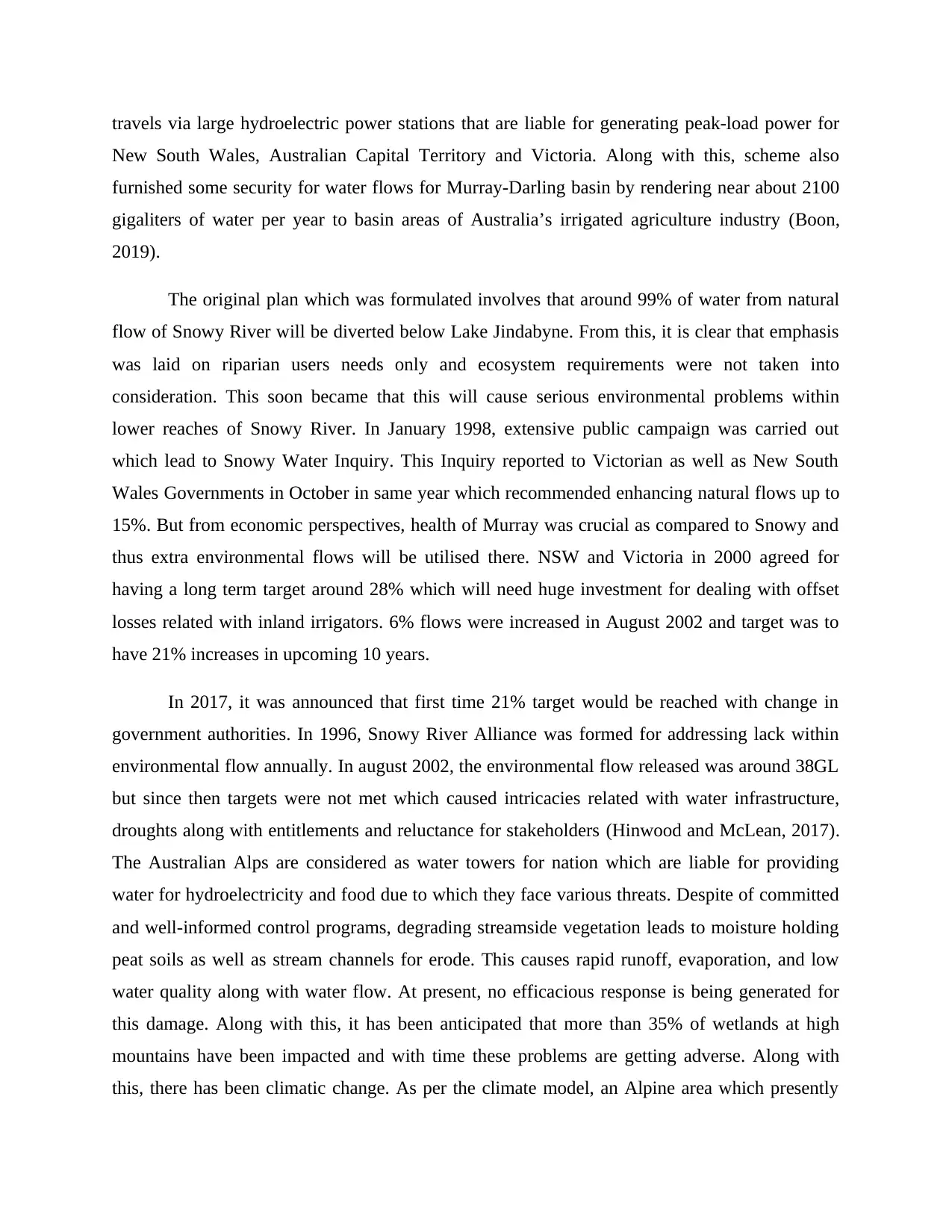
travels via large hydroelectric power stations that are liable for generating peak-load power for
New South Wales, Australian Capital Territory and Victoria. Along with this, scheme also
furnished some security for water flows for Murray-Darling basin by rendering near about 2100
gigaliters of water per year to basin areas of Australia’s irrigated agriculture industry (Boon,
2019).
The original plan which was formulated involves that around 99% of water from natural
flow of Snowy River will be diverted below Lake Jindabyne. From this, it is clear that emphasis
was laid on riparian users needs only and ecosystem requirements were not taken into
consideration. This soon became that this will cause serious environmental problems within
lower reaches of Snowy River. In January 1998, extensive public campaign was carried out
which lead to Snowy Water Inquiry. This Inquiry reported to Victorian as well as New South
Wales Governments in October in same year which recommended enhancing natural flows up to
15%. But from economic perspectives, health of Murray was crucial as compared to Snowy and
thus extra environmental flows will be utilised there. NSW and Victoria in 2000 agreed for
having a long term target around 28% which will need huge investment for dealing with offset
losses related with inland irrigators. 6% flows were increased in August 2002 and target was to
have 21% increases in upcoming 10 years.
In 2017, it was announced that first time 21% target would be reached with change in
government authorities. In 1996, Snowy River Alliance was formed for addressing lack within
environmental flow annually. In august 2002, the environmental flow released was around 38GL
but since then targets were not met which caused intricacies related with water infrastructure,
droughts along with entitlements and reluctance for stakeholders (Hinwood and McLean, 2017).
The Australian Alps are considered as water towers for nation which are liable for providing
water for hydroelectricity and food due to which they face various threats. Despite of committed
and well-informed control programs, degrading streamside vegetation leads to moisture holding
peat soils as well as stream channels for erode. This causes rapid runoff, evaporation, and low
water quality along with water flow. At present, no efficacious response is being generated for
this damage. Along with this, it has been anticipated that more than 35% of wetlands at high
mountains have been impacted and with time these problems are getting adverse. Along with
this, there has been climatic change. As per the climate model, an Alpine area which presently
New South Wales, Australian Capital Territory and Victoria. Along with this, scheme also
furnished some security for water flows for Murray-Darling basin by rendering near about 2100
gigaliters of water per year to basin areas of Australia’s irrigated agriculture industry (Boon,
2019).
The original plan which was formulated involves that around 99% of water from natural
flow of Snowy River will be diverted below Lake Jindabyne. From this, it is clear that emphasis
was laid on riparian users needs only and ecosystem requirements were not taken into
consideration. This soon became that this will cause serious environmental problems within
lower reaches of Snowy River. In January 1998, extensive public campaign was carried out
which lead to Snowy Water Inquiry. This Inquiry reported to Victorian as well as New South
Wales Governments in October in same year which recommended enhancing natural flows up to
15%. But from economic perspectives, health of Murray was crucial as compared to Snowy and
thus extra environmental flows will be utilised there. NSW and Victoria in 2000 agreed for
having a long term target around 28% which will need huge investment for dealing with offset
losses related with inland irrigators. 6% flows were increased in August 2002 and target was to
have 21% increases in upcoming 10 years.
In 2017, it was announced that first time 21% target would be reached with change in
government authorities. In 1996, Snowy River Alliance was formed for addressing lack within
environmental flow annually. In august 2002, the environmental flow released was around 38GL
but since then targets were not met which caused intricacies related with water infrastructure,
droughts along with entitlements and reluctance for stakeholders (Hinwood and McLean, 2017).
The Australian Alps are considered as water towers for nation which are liable for providing
water for hydroelectricity and food due to which they face various threats. Despite of committed
and well-informed control programs, degrading streamside vegetation leads to moisture holding
peat soils as well as stream channels for erode. This causes rapid runoff, evaporation, and low
water quality along with water flow. At present, no efficacious response is being generated for
this damage. Along with this, it has been anticipated that more than 35% of wetlands at high
mountains have been impacted and with time these problems are getting adverse. Along with
this, there has been climatic change. As per the climate model, an Alpine area which presently
Paraphrase This Document
Need a fresh take? Get an instant paraphrase of this document with our AI Paraphraser
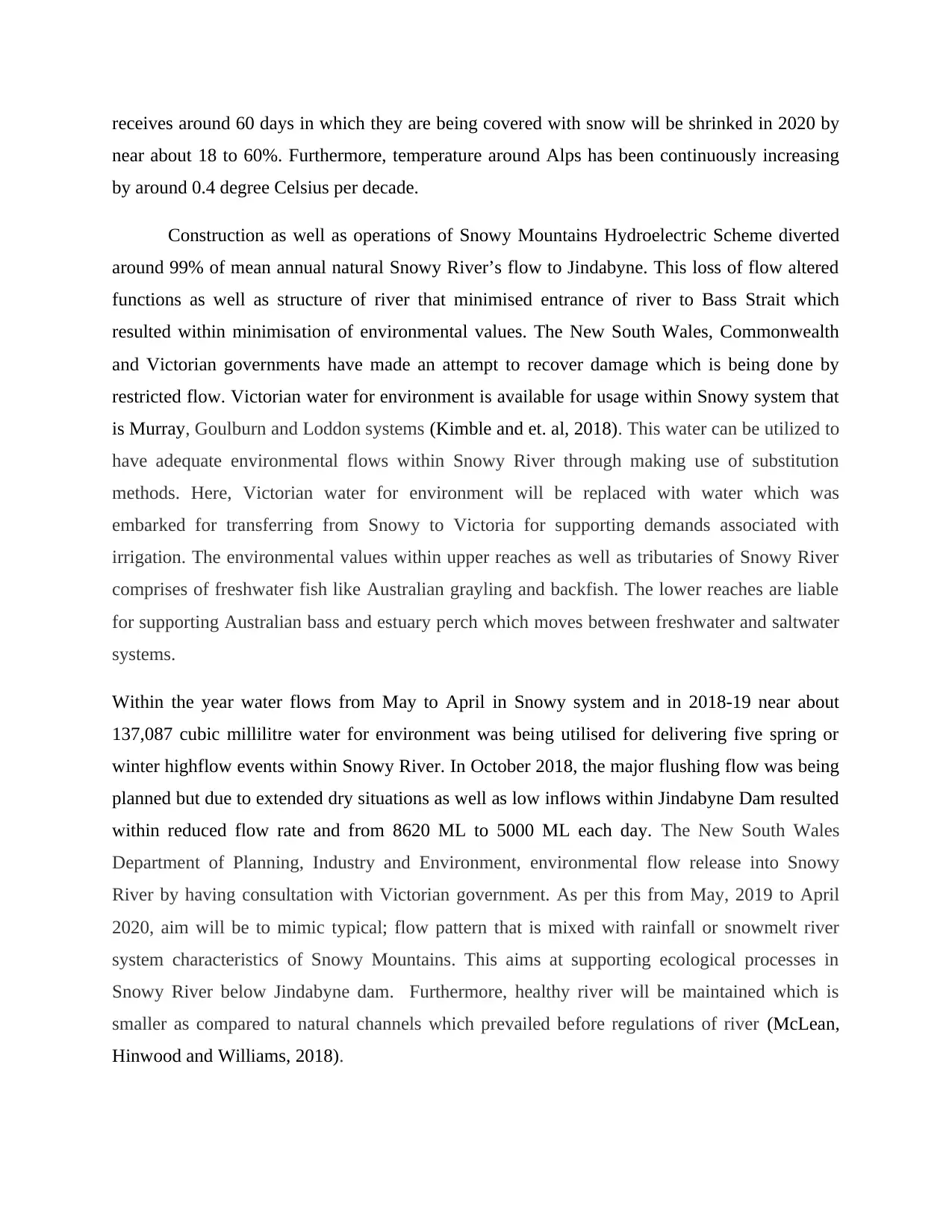
receives around 60 days in which they are being covered with snow will be shrinked in 2020 by
near about 18 to 60%. Furthermore, temperature around Alps has been continuously increasing
by around 0.4 degree Celsius per decade.
Construction as well as operations of Snowy Mountains Hydroelectric Scheme diverted
around 99% of mean annual natural Snowy River’s flow to Jindabyne. This loss of flow altered
functions as well as structure of river that minimised entrance of river to Bass Strait which
resulted within minimisation of environmental values. The New South Wales, Commonwealth
and Victorian governments have made an attempt to recover damage which is being done by
restricted flow. Victorian water for environment is available for usage within Snowy system that
is Murray, Goulburn and Loddon systems (Kimble and et. al, 2018). This water can be utilized to
have adequate environmental flows within Snowy River through making use of substitution
methods. Here, Victorian water for environment will be replaced with water which was
embarked for transferring from Snowy to Victoria for supporting demands associated with
irrigation. The environmental values within upper reaches as well as tributaries of Snowy River
comprises of freshwater fish like Australian grayling and backfish. The lower reaches are liable
for supporting Australian bass and estuary perch which moves between freshwater and saltwater
systems.
Within the year water flows from May to April in Snowy system and in 2018-19 near about
137,087 cubic millilitre water for environment was being utilised for delivering five spring or
winter highflow events within Snowy River. In October 2018, the major flushing flow was being
planned but due to extended dry situations as well as low inflows within Jindabyne Dam resulted
within reduced flow rate and from 8620 ML to 5000 ML each day. The New South Wales
Department of Planning, Industry and Environment, environmental flow release into Snowy
River by having consultation with Victorian government. As per this from May, 2019 to April
2020, aim will be to mimic typical; flow pattern that is mixed with rainfall or snowmelt river
system characteristics of Snowy Mountains. This aims at supporting ecological processes in
Snowy River below Jindabyne dam. Furthermore, healthy river will be maintained which is
smaller as compared to natural channels which prevailed before regulations of river (McLean,
Hinwood and Williams, 2018).
near about 18 to 60%. Furthermore, temperature around Alps has been continuously increasing
by around 0.4 degree Celsius per decade.
Construction as well as operations of Snowy Mountains Hydroelectric Scheme diverted
around 99% of mean annual natural Snowy River’s flow to Jindabyne. This loss of flow altered
functions as well as structure of river that minimised entrance of river to Bass Strait which
resulted within minimisation of environmental values. The New South Wales, Commonwealth
and Victorian governments have made an attempt to recover damage which is being done by
restricted flow. Victorian water for environment is available for usage within Snowy system that
is Murray, Goulburn and Loddon systems (Kimble and et. al, 2018). This water can be utilized to
have adequate environmental flows within Snowy River through making use of substitution
methods. Here, Victorian water for environment will be replaced with water which was
embarked for transferring from Snowy to Victoria for supporting demands associated with
irrigation. The environmental values within upper reaches as well as tributaries of Snowy River
comprises of freshwater fish like Australian grayling and backfish. The lower reaches are liable
for supporting Australian bass and estuary perch which moves between freshwater and saltwater
systems.
Within the year water flows from May to April in Snowy system and in 2018-19 near about
137,087 cubic millilitre water for environment was being utilised for delivering five spring or
winter highflow events within Snowy River. In October 2018, the major flushing flow was being
planned but due to extended dry situations as well as low inflows within Jindabyne Dam resulted
within reduced flow rate and from 8620 ML to 5000 ML each day. The New South Wales
Department of Planning, Industry and Environment, environmental flow release into Snowy
River by having consultation with Victorian government. As per this from May, 2019 to April
2020, aim will be to mimic typical; flow pattern that is mixed with rainfall or snowmelt river
system characteristics of Snowy Mountains. This aims at supporting ecological processes in
Snowy River below Jindabyne dam. Furthermore, healthy river will be maintained which is
smaller as compared to natural channels which prevailed before regulations of river (McLean,
Hinwood and Williams, 2018).
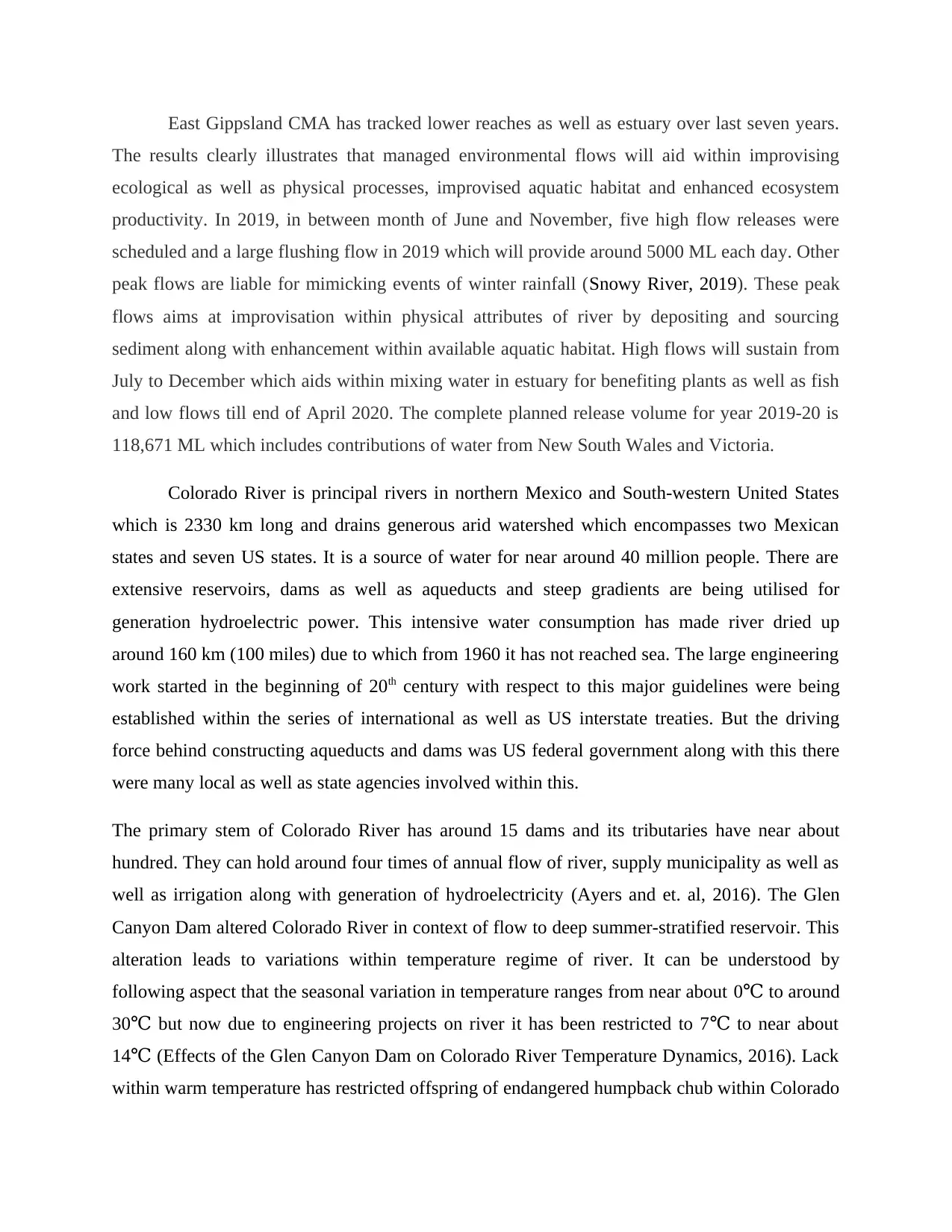
East Gippsland CMA has tracked lower reaches as well as estuary over last seven years.
The results clearly illustrates that managed environmental flows will aid within improvising
ecological as well as physical processes, improvised aquatic habitat and enhanced ecosystem
productivity. In 2019, in between month of June and November, five high flow releases were
scheduled and a large flushing flow in 2019 which will provide around 5000 ML each day. Other
peak flows are liable for mimicking events of winter rainfall (Snowy River, 2019). These peak
flows aims at improvisation within physical attributes of river by depositing and sourcing
sediment along with enhancement within available aquatic habitat. High flows will sustain from
July to December which aids within mixing water in estuary for benefiting plants as well as fish
and low flows till end of April 2020. The complete planned release volume for year 2019-20 is
118,671 ML which includes contributions of water from New South Wales and Victoria.
Colorado River is principal rivers in northern Mexico and South-western United States
which is 2330 km long and drains generous arid watershed which encompasses two Mexican
states and seven US states. It is a source of water for near around 40 million people. There are
extensive reservoirs, dams as well as aqueducts and steep gradients are being utilised for
generation hydroelectric power. This intensive water consumption has made river dried up
around 160 km (100 miles) due to which from 1960 it has not reached sea. The large engineering
work started in the beginning of 20th century with respect to this major guidelines were being
established within the series of international as well as US interstate treaties. But the driving
force behind constructing aqueducts and dams was US federal government along with this there
were many local as well as state agencies involved within this.
The primary stem of Colorado River has around 15 dams and its tributaries have near about
hundred. They can hold around four times of annual flow of river, supply municipality as well as
well as irrigation along with generation of hydroelectricity (Ayers and et. al, 2016). The Glen
Canyon Dam altered Colorado River in context of flow to deep summer-stratified reservoir. This
alteration leads to variations within temperature regime of river. It can be understood by
following aspect that the seasonal variation in temperature ranges from near about 0 to around℃
30 but now due to engineering projects on river it has been restricted to 7 to near about℃ ℃
14 (Effects of the Glen Canyon Dam on Colorado River Temperature Dynamics, 2016). Lack℃
within warm temperature has restricted offspring of endangered humpback chub within Colorado
The results clearly illustrates that managed environmental flows will aid within improvising
ecological as well as physical processes, improvised aquatic habitat and enhanced ecosystem
productivity. In 2019, in between month of June and November, five high flow releases were
scheduled and a large flushing flow in 2019 which will provide around 5000 ML each day. Other
peak flows are liable for mimicking events of winter rainfall (Snowy River, 2019). These peak
flows aims at improvisation within physical attributes of river by depositing and sourcing
sediment along with enhancement within available aquatic habitat. High flows will sustain from
July to December which aids within mixing water in estuary for benefiting plants as well as fish
and low flows till end of April 2020. The complete planned release volume for year 2019-20 is
118,671 ML which includes contributions of water from New South Wales and Victoria.
Colorado River is principal rivers in northern Mexico and South-western United States
which is 2330 km long and drains generous arid watershed which encompasses two Mexican
states and seven US states. It is a source of water for near around 40 million people. There are
extensive reservoirs, dams as well as aqueducts and steep gradients are being utilised for
generation hydroelectric power. This intensive water consumption has made river dried up
around 160 km (100 miles) due to which from 1960 it has not reached sea. The large engineering
work started in the beginning of 20th century with respect to this major guidelines were being
established within the series of international as well as US interstate treaties. But the driving
force behind constructing aqueducts and dams was US federal government along with this there
were many local as well as state agencies involved within this.
The primary stem of Colorado River has around 15 dams and its tributaries have near about
hundred. They can hold around four times of annual flow of river, supply municipality as well as
well as irrigation along with generation of hydroelectricity (Ayers and et. al, 2016). The Glen
Canyon Dam altered Colorado River in context of flow to deep summer-stratified reservoir. This
alteration leads to variations within temperature regime of river. It can be understood by
following aspect that the seasonal variation in temperature ranges from near about 0 to around℃
30 but now due to engineering projects on river it has been restricted to 7 to near about℃ ℃
14 (Effects of the Glen Canyon Dam on Colorado River Temperature Dynamics, 2016). Lack℃
within warm temperature has restricted offspring of endangered humpback chub within Colorado
⊘ This is a preview!⊘
Do you want full access?
Subscribe today to unlock all pages.

Trusted by 1+ million students worldwide
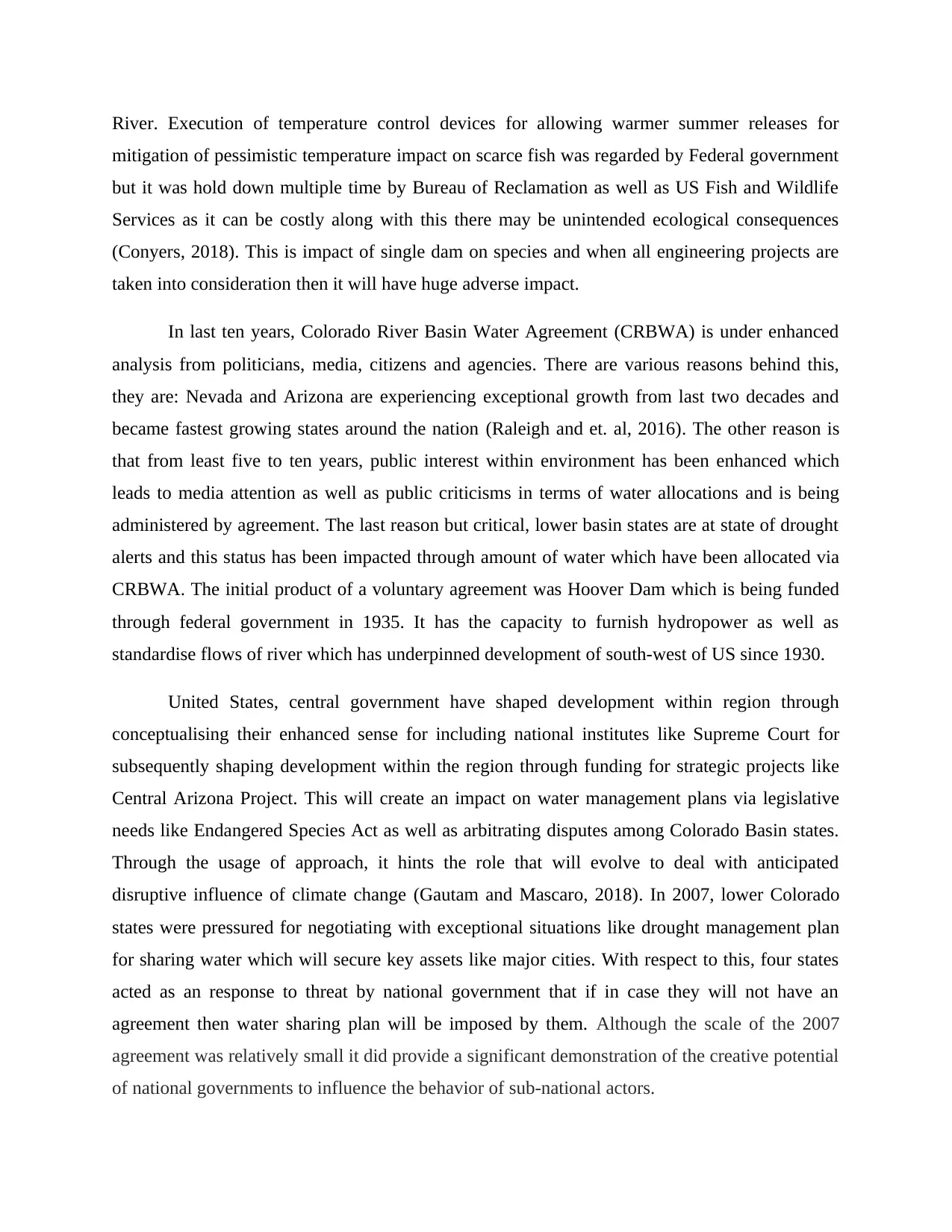
River. Execution of temperature control devices for allowing warmer summer releases for
mitigation of pessimistic temperature impact on scarce fish was regarded by Federal government
but it was hold down multiple time by Bureau of Reclamation as well as US Fish and Wildlife
Services as it can be costly along with this there may be unintended ecological consequences
(Conyers, 2018). This is impact of single dam on species and when all engineering projects are
taken into consideration then it will have huge adverse impact.
In last ten years, Colorado River Basin Water Agreement (CRBWA) is under enhanced
analysis from politicians, media, citizens and agencies. There are various reasons behind this,
they are: Nevada and Arizona are experiencing exceptional growth from last two decades and
became fastest growing states around the nation (Raleigh and et. al, 2016). The other reason is
that from least five to ten years, public interest within environment has been enhanced which
leads to media attention as well as public criticisms in terms of water allocations and is being
administered by agreement. The last reason but critical, lower basin states are at state of drought
alerts and this status has been impacted through amount of water which have been allocated via
CRBWA. The initial product of a voluntary agreement was Hoover Dam which is being funded
through federal government in 1935. It has the capacity to furnish hydropower as well as
standardise flows of river which has underpinned development of south-west of US since 1930.
United States, central government have shaped development within region through
conceptualising their enhanced sense for including national institutes like Supreme Court for
subsequently shaping development within the region through funding for strategic projects like
Central Arizona Project. This will create an impact on water management plans via legislative
needs like Endangered Species Act as well as arbitrating disputes among Colorado Basin states.
Through the usage of approach, it hints the role that will evolve to deal with anticipated
disruptive influence of climate change (Gautam and Mascaro, 2018). In 2007, lower Colorado
states were pressured for negotiating with exceptional situations like drought management plan
for sharing water which will secure key assets like major cities. With respect to this, four states
acted as an response to threat by national government that if in case they will not have an
agreement then water sharing plan will be imposed by them. Although the scale of the 2007
agreement was relatively small it did provide a significant demonstration of the creative potential
of national governments to influence the behavior of sub-national actors.
mitigation of pessimistic temperature impact on scarce fish was regarded by Federal government
but it was hold down multiple time by Bureau of Reclamation as well as US Fish and Wildlife
Services as it can be costly along with this there may be unintended ecological consequences
(Conyers, 2018). This is impact of single dam on species and when all engineering projects are
taken into consideration then it will have huge adverse impact.
In last ten years, Colorado River Basin Water Agreement (CRBWA) is under enhanced
analysis from politicians, media, citizens and agencies. There are various reasons behind this,
they are: Nevada and Arizona are experiencing exceptional growth from last two decades and
became fastest growing states around the nation (Raleigh and et. al, 2016). The other reason is
that from least five to ten years, public interest within environment has been enhanced which
leads to media attention as well as public criticisms in terms of water allocations and is being
administered by agreement. The last reason but critical, lower basin states are at state of drought
alerts and this status has been impacted through amount of water which have been allocated via
CRBWA. The initial product of a voluntary agreement was Hoover Dam which is being funded
through federal government in 1935. It has the capacity to furnish hydropower as well as
standardise flows of river which has underpinned development of south-west of US since 1930.
United States, central government have shaped development within region through
conceptualising their enhanced sense for including national institutes like Supreme Court for
subsequently shaping development within the region through funding for strategic projects like
Central Arizona Project. This will create an impact on water management plans via legislative
needs like Endangered Species Act as well as arbitrating disputes among Colorado Basin states.
Through the usage of approach, it hints the role that will evolve to deal with anticipated
disruptive influence of climate change (Gautam and Mascaro, 2018). In 2007, lower Colorado
states were pressured for negotiating with exceptional situations like drought management plan
for sharing water which will secure key assets like major cities. With respect to this, four states
acted as an response to threat by national government that if in case they will not have an
agreement then water sharing plan will be imposed by them. Although the scale of the 2007
agreement was relatively small it did provide a significant demonstration of the creative potential
of national governments to influence the behavior of sub-national actors.
Paraphrase This Document
Need a fresh take? Get an instant paraphrase of this document with our AI Paraphraser
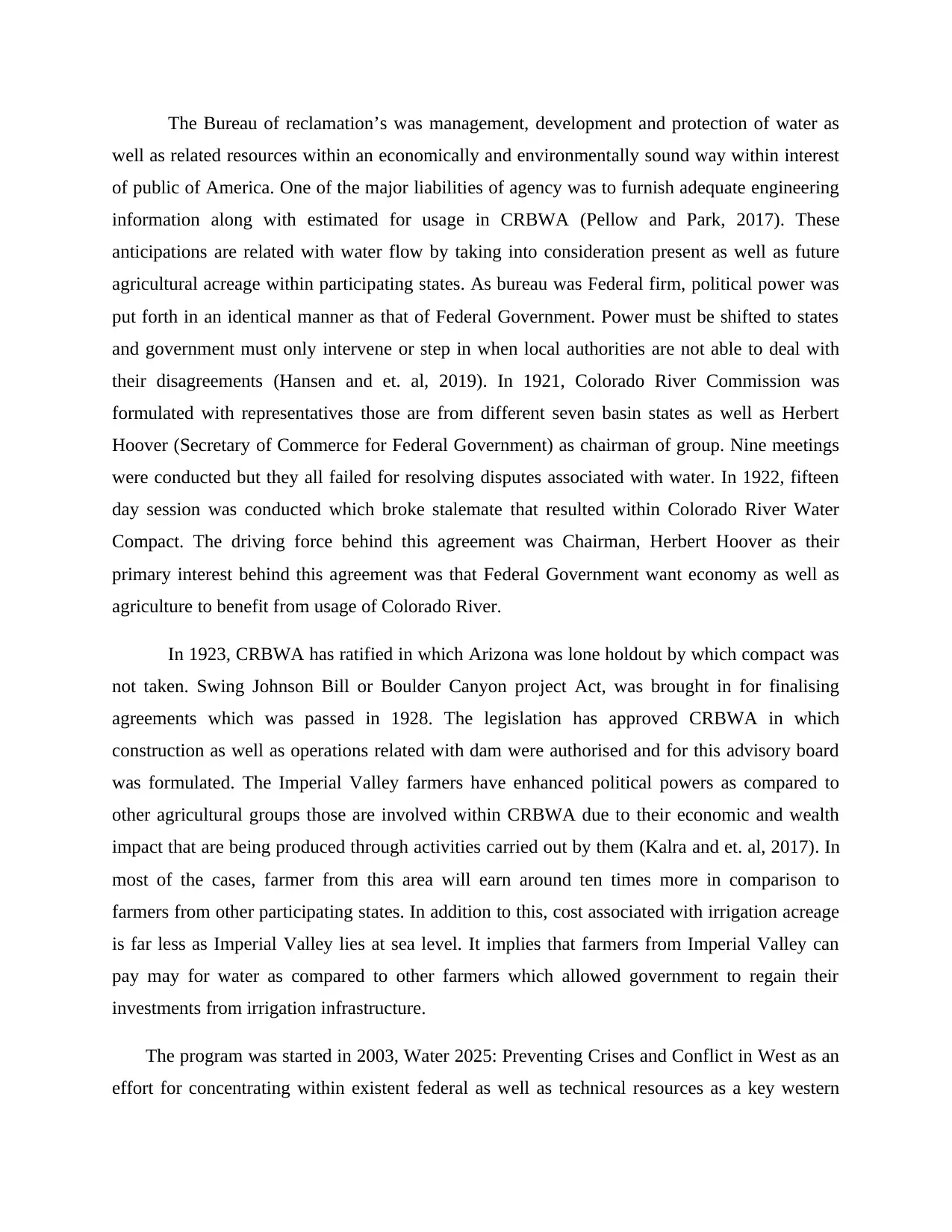
The Bureau of reclamation’s was management, development and protection of water as
well as related resources within an economically and environmentally sound way within interest
of public of America. One of the major liabilities of agency was to furnish adequate engineering
information along with estimated for usage in CRBWA (Pellow and Park, 2017). These
anticipations are related with water flow by taking into consideration present as well as future
agricultural acreage within participating states. As bureau was Federal firm, political power was
put forth in an identical manner as that of Federal Government. Power must be shifted to states
and government must only intervene or step in when local authorities are not able to deal with
their disagreements (Hansen and et. al, 2019). In 1921, Colorado River Commission was
formulated with representatives those are from different seven basin states as well as Herbert
Hoover (Secretary of Commerce for Federal Government) as chairman of group. Nine meetings
were conducted but they all failed for resolving disputes associated with water. In 1922, fifteen
day session was conducted which broke stalemate that resulted within Colorado River Water
Compact. The driving force behind this agreement was Chairman, Herbert Hoover as their
primary interest behind this agreement was that Federal Government want economy as well as
agriculture to benefit from usage of Colorado River.
In 1923, CRBWA has ratified in which Arizona was lone holdout by which compact was
not taken. Swing Johnson Bill or Boulder Canyon project Act, was brought in for finalising
agreements which was passed in 1928. The legislation has approved CRBWA in which
construction as well as operations related with dam were authorised and for this advisory board
was formulated. The Imperial Valley farmers have enhanced political powers as compared to
other agricultural groups those are involved within CRBWA due to their economic and wealth
impact that are being produced through activities carried out by them (Kalra and et. al, 2017). In
most of the cases, farmer from this area will earn around ten times more in comparison to
farmers from other participating states. In addition to this, cost associated with irrigation acreage
is far less as Imperial Valley lies at sea level. It implies that farmers from Imperial Valley can
pay may for water as compared to other farmers which allowed government to regain their
investments from irrigation infrastructure.
The program was started in 2003, Water 2025: Preventing Crises and Conflict in West as an
effort for concentrating within existent federal as well as technical resources as a key western
well as related resources within an economically and environmentally sound way within interest
of public of America. One of the major liabilities of agency was to furnish adequate engineering
information along with estimated for usage in CRBWA (Pellow and Park, 2017). These
anticipations are related with water flow by taking into consideration present as well as future
agricultural acreage within participating states. As bureau was Federal firm, political power was
put forth in an identical manner as that of Federal Government. Power must be shifted to states
and government must only intervene or step in when local authorities are not able to deal with
their disagreements (Hansen and et. al, 2019). In 1921, Colorado River Commission was
formulated with representatives those are from different seven basin states as well as Herbert
Hoover (Secretary of Commerce for Federal Government) as chairman of group. Nine meetings
were conducted but they all failed for resolving disputes associated with water. In 1922, fifteen
day session was conducted which broke stalemate that resulted within Colorado River Water
Compact. The driving force behind this agreement was Chairman, Herbert Hoover as their
primary interest behind this agreement was that Federal Government want economy as well as
agriculture to benefit from usage of Colorado River.
In 1923, CRBWA has ratified in which Arizona was lone holdout by which compact was
not taken. Swing Johnson Bill or Boulder Canyon project Act, was brought in for finalising
agreements which was passed in 1928. The legislation has approved CRBWA in which
construction as well as operations related with dam were authorised and for this advisory board
was formulated. The Imperial Valley farmers have enhanced political powers as compared to
other agricultural groups those are involved within CRBWA due to their economic and wealth
impact that are being produced through activities carried out by them (Kalra and et. al, 2017). In
most of the cases, farmer from this area will earn around ten times more in comparison to
farmers from other participating states. In addition to this, cost associated with irrigation acreage
is far less as Imperial Valley lies at sea level. It implies that farmers from Imperial Valley can
pay may for water as compared to other farmers which allowed government to regain their
investments from irrigation infrastructure.
The program was started in 2003, Water 2025: Preventing Crises and Conflict in West as an
effort for concentrating within existent federal as well as technical resources as a key western
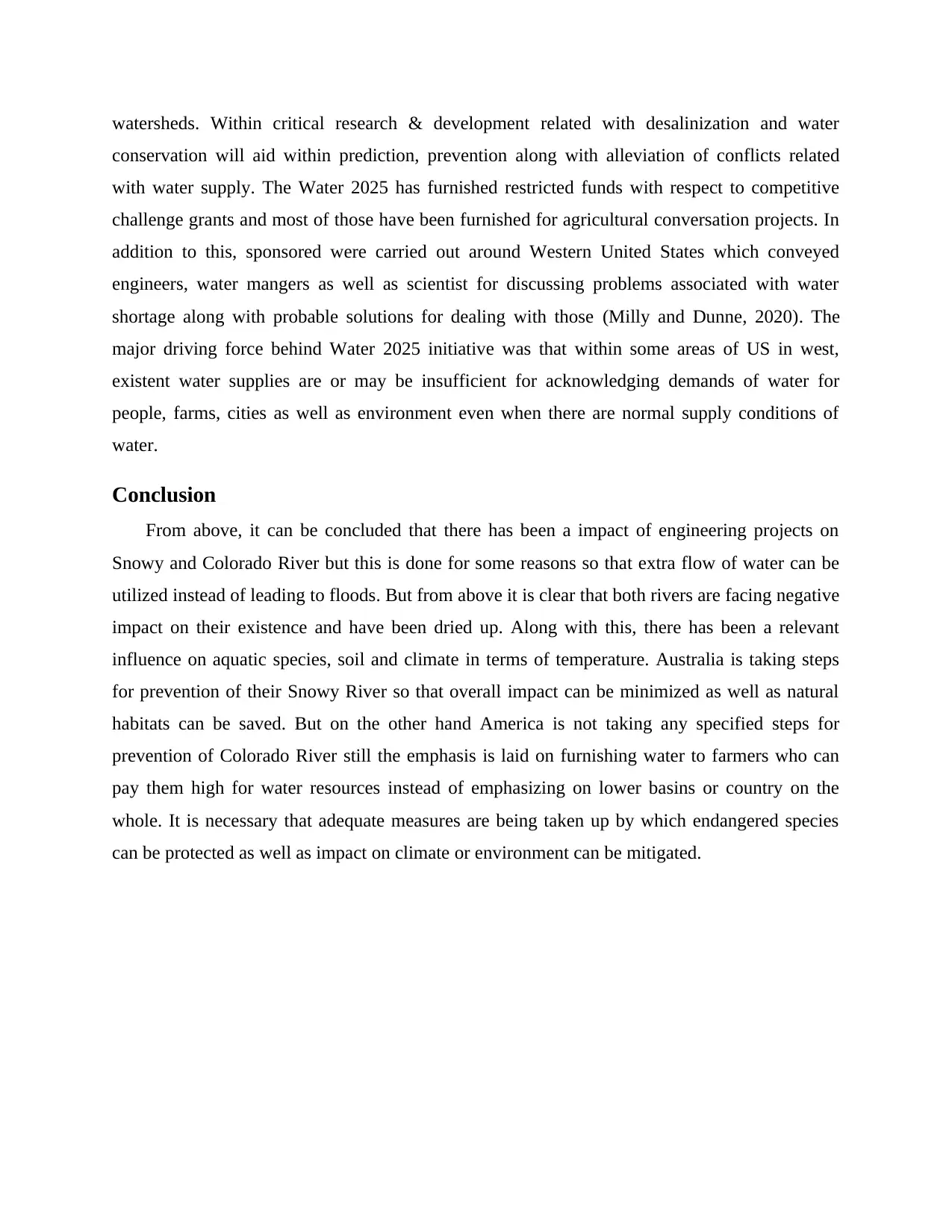
watersheds. Within critical research & development related with desalinization and water
conservation will aid within prediction, prevention along with alleviation of conflicts related
with water supply. The Water 2025 has furnished restricted funds with respect to competitive
challenge grants and most of those have been furnished for agricultural conversation projects. In
addition to this, sponsored were carried out around Western United States which conveyed
engineers, water mangers as well as scientist for discussing problems associated with water
shortage along with probable solutions for dealing with those (Milly and Dunne, 2020). The
major driving force behind Water 2025 initiative was that within some areas of US in west,
existent water supplies are or may be insufficient for acknowledging demands of water for
people, farms, cities as well as environment even when there are normal supply conditions of
water.
Conclusion
From above, it can be concluded that there has been a impact of engineering projects on
Snowy and Colorado River but this is done for some reasons so that extra flow of water can be
utilized instead of leading to floods. But from above it is clear that both rivers are facing negative
impact on their existence and have been dried up. Along with this, there has been a relevant
influence on aquatic species, soil and climate in terms of temperature. Australia is taking steps
for prevention of their Snowy River so that overall impact can be minimized as well as natural
habitats can be saved. But on the other hand America is not taking any specified steps for
prevention of Colorado River still the emphasis is laid on furnishing water to farmers who can
pay them high for water resources instead of emphasizing on lower basins or country on the
whole. It is necessary that adequate measures are being taken up by which endangered species
can be protected as well as impact on climate or environment can be mitigated.
conservation will aid within prediction, prevention along with alleviation of conflicts related
with water supply. The Water 2025 has furnished restricted funds with respect to competitive
challenge grants and most of those have been furnished for agricultural conversation projects. In
addition to this, sponsored were carried out around Western United States which conveyed
engineers, water mangers as well as scientist for discussing problems associated with water
shortage along with probable solutions for dealing with those (Milly and Dunne, 2020). The
major driving force behind Water 2025 initiative was that within some areas of US in west,
existent water supplies are or may be insufficient for acknowledging demands of water for
people, farms, cities as well as environment even when there are normal supply conditions of
water.
Conclusion
From above, it can be concluded that there has been a impact of engineering projects on
Snowy and Colorado River but this is done for some reasons so that extra flow of water can be
utilized instead of leading to floods. But from above it is clear that both rivers are facing negative
impact on their existence and have been dried up. Along with this, there has been a relevant
influence on aquatic species, soil and climate in terms of temperature. Australia is taking steps
for prevention of their Snowy River so that overall impact can be minimized as well as natural
habitats can be saved. But on the other hand America is not taking any specified steps for
prevention of Colorado River still the emphasis is laid on furnishing water to farmers who can
pay them high for water resources instead of emphasizing on lower basins or country on the
whole. It is necessary that adequate measures are being taken up by which endangered species
can be protected as well as impact on climate or environment can be mitigated.
⊘ This is a preview!⊘
Do you want full access?
Subscribe today to unlock all pages.

Trusted by 1+ million students worldwide
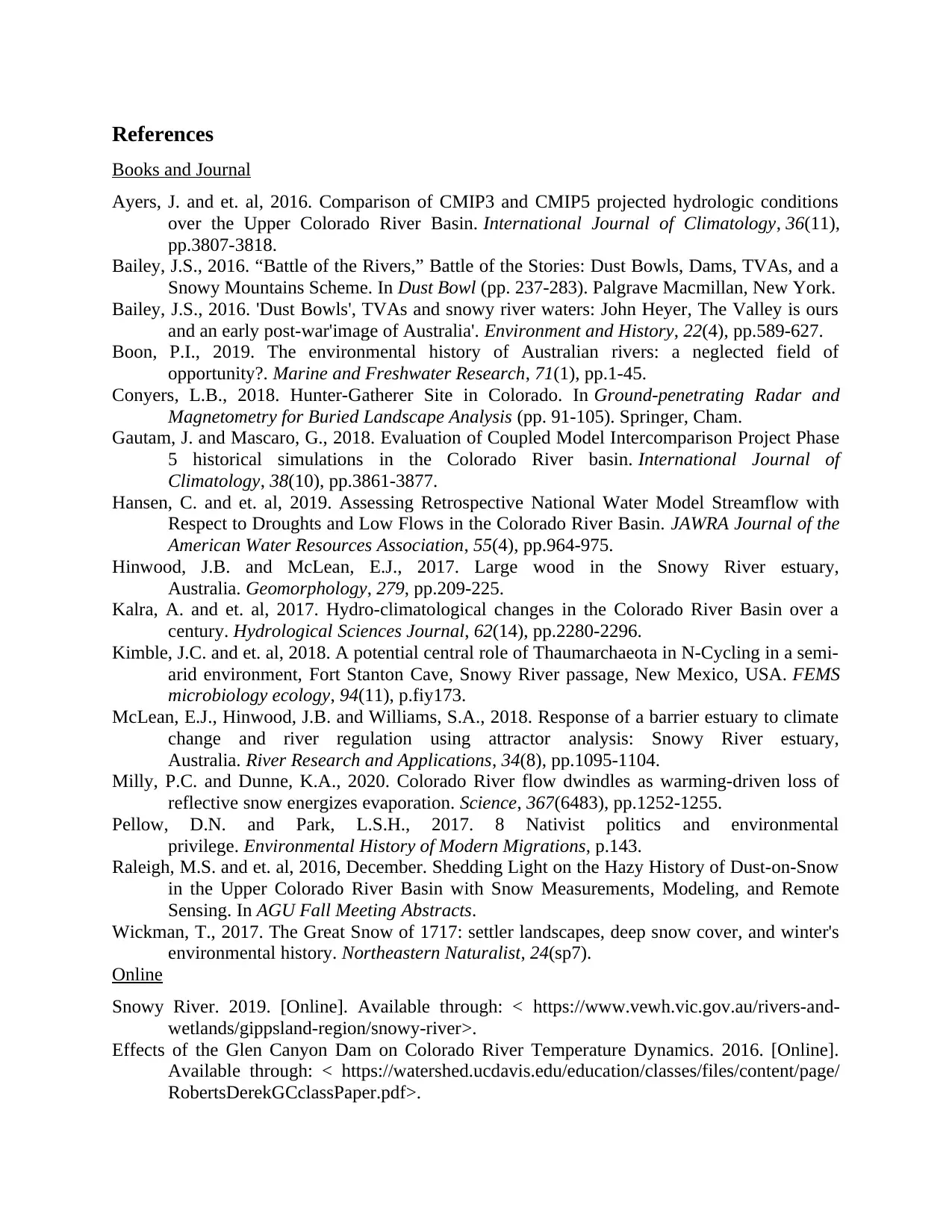
References
Books and Journal
Ayers, J. and et. al, 2016. Comparison of CMIP3 and CMIP5 projected hydrologic conditions
over the Upper Colorado River Basin. International Journal of Climatology, 36(11),
pp.3807-3818.
Bailey, J.S., 2016. “Battle of the Rivers,” Battle of the Stories: Dust Bowls, Dams, TVAs, and a
Snowy Mountains Scheme. In Dust Bowl (pp. 237-283). Palgrave Macmillan, New York.
Bailey, J.S., 2016. 'Dust Bowls', TVAs and snowy river waters: John Heyer, The Valley is ours
and an early post-war'image of Australia'. Environment and History, 22(4), pp.589-627.
Boon, P.I., 2019. The environmental history of Australian rivers: a neglected field of
opportunity?. Marine and Freshwater Research, 71(1), pp.1-45.
Conyers, L.B., 2018. Hunter-Gatherer Site in Colorado. In Ground-penetrating Radar and
Magnetometry for Buried Landscape Analysis (pp. 91-105). Springer, Cham.
Gautam, J. and Mascaro, G., 2018. Evaluation of Coupled Model Intercomparison Project Phase
5 historical simulations in the Colorado River basin. International Journal of
Climatology, 38(10), pp.3861-3877.
Hansen, C. and et. al, 2019. Assessing Retrospective National Water Model Streamflow with
Respect to Droughts and Low Flows in the Colorado River Basin. JAWRA Journal of the
American Water Resources Association, 55(4), pp.964-975.
Hinwood, J.B. and McLean, E.J., 2017. Large wood in the Snowy River estuary,
Australia. Geomorphology, 279, pp.209-225.
Kalra, A. and et. al, 2017. Hydro-climatological changes in the Colorado River Basin over a
century. Hydrological Sciences Journal, 62(14), pp.2280-2296.
Kimble, J.C. and et. al, 2018. A potential central role of Thaumarchaeota in N-Cycling in a semi-
arid environment, Fort Stanton Cave, Snowy River passage, New Mexico, USA. FEMS
microbiology ecology, 94(11), p.fiy173.
McLean, E.J., Hinwood, J.B. and Williams, S.A., 2018. Response of a barrier estuary to climate
change and river regulation using attractor analysis: Snowy River estuary,
Australia. River Research and Applications, 34(8), pp.1095-1104.
Milly, P.C. and Dunne, K.A., 2020. Colorado River flow dwindles as warming-driven loss of
reflective snow energizes evaporation. Science, 367(6483), pp.1252-1255.
Pellow, D.N. and Park, L.S.H., 2017. 8 Nativist politics and environmental
privilege. Environmental History of Modern Migrations, p.143.
Raleigh, M.S. and et. al, 2016, December. Shedding Light on the Hazy History of Dust-on-Snow
in the Upper Colorado River Basin with Snow Measurements, Modeling, and Remote
Sensing. In AGU Fall Meeting Abstracts.
Wickman, T., 2017. The Great Snow of 1717: settler landscapes, deep snow cover, and winter's
environmental history. Northeastern Naturalist, 24(sp7).
Online
Snowy River. 2019. [Online]. Available through: < https://www.vewh.vic.gov.au/rivers-and-
wetlands/gippsland-region/snowy-river>.
Effects of the Glen Canyon Dam on Colorado River Temperature Dynamics. 2016. [Online].
Available through: < https://watershed.ucdavis.edu/education/classes/files/content/page/
RobertsDerekGCclassPaper.pdf>.
Books and Journal
Ayers, J. and et. al, 2016. Comparison of CMIP3 and CMIP5 projected hydrologic conditions
over the Upper Colorado River Basin. International Journal of Climatology, 36(11),
pp.3807-3818.
Bailey, J.S., 2016. “Battle of the Rivers,” Battle of the Stories: Dust Bowls, Dams, TVAs, and a
Snowy Mountains Scheme. In Dust Bowl (pp. 237-283). Palgrave Macmillan, New York.
Bailey, J.S., 2016. 'Dust Bowls', TVAs and snowy river waters: John Heyer, The Valley is ours
and an early post-war'image of Australia'. Environment and History, 22(4), pp.589-627.
Boon, P.I., 2019. The environmental history of Australian rivers: a neglected field of
opportunity?. Marine and Freshwater Research, 71(1), pp.1-45.
Conyers, L.B., 2018. Hunter-Gatherer Site in Colorado. In Ground-penetrating Radar and
Magnetometry for Buried Landscape Analysis (pp. 91-105). Springer, Cham.
Gautam, J. and Mascaro, G., 2018. Evaluation of Coupled Model Intercomparison Project Phase
5 historical simulations in the Colorado River basin. International Journal of
Climatology, 38(10), pp.3861-3877.
Hansen, C. and et. al, 2019. Assessing Retrospective National Water Model Streamflow with
Respect to Droughts and Low Flows in the Colorado River Basin. JAWRA Journal of the
American Water Resources Association, 55(4), pp.964-975.
Hinwood, J.B. and McLean, E.J., 2017. Large wood in the Snowy River estuary,
Australia. Geomorphology, 279, pp.209-225.
Kalra, A. and et. al, 2017. Hydro-climatological changes in the Colorado River Basin over a
century. Hydrological Sciences Journal, 62(14), pp.2280-2296.
Kimble, J.C. and et. al, 2018. A potential central role of Thaumarchaeota in N-Cycling in a semi-
arid environment, Fort Stanton Cave, Snowy River passage, New Mexico, USA. FEMS
microbiology ecology, 94(11), p.fiy173.
McLean, E.J., Hinwood, J.B. and Williams, S.A., 2018. Response of a barrier estuary to climate
change and river regulation using attractor analysis: Snowy River estuary,
Australia. River Research and Applications, 34(8), pp.1095-1104.
Milly, P.C. and Dunne, K.A., 2020. Colorado River flow dwindles as warming-driven loss of
reflective snow energizes evaporation. Science, 367(6483), pp.1252-1255.
Pellow, D.N. and Park, L.S.H., 2017. 8 Nativist politics and environmental
privilege. Environmental History of Modern Migrations, p.143.
Raleigh, M.S. and et. al, 2016, December. Shedding Light on the Hazy History of Dust-on-Snow
in the Upper Colorado River Basin with Snow Measurements, Modeling, and Remote
Sensing. In AGU Fall Meeting Abstracts.
Wickman, T., 2017. The Great Snow of 1717: settler landscapes, deep snow cover, and winter's
environmental history. Northeastern Naturalist, 24(sp7).
Online
Snowy River. 2019. [Online]. Available through: < https://www.vewh.vic.gov.au/rivers-and-
wetlands/gippsland-region/snowy-river>.
Effects of the Glen Canyon Dam on Colorado River Temperature Dynamics. 2016. [Online].
Available through: < https://watershed.ucdavis.edu/education/classes/files/content/page/
RobertsDerekGCclassPaper.pdf>.
1 out of 10
Related Documents
Your All-in-One AI-Powered Toolkit for Academic Success.
+13062052269
info@desklib.com
Available 24*7 on WhatsApp / Email
![[object Object]](/_next/static/media/star-bottom.7253800d.svg)
Unlock your academic potential
Copyright © 2020–2025 A2Z Services. All Rights Reserved. Developed and managed by ZUCOL.




